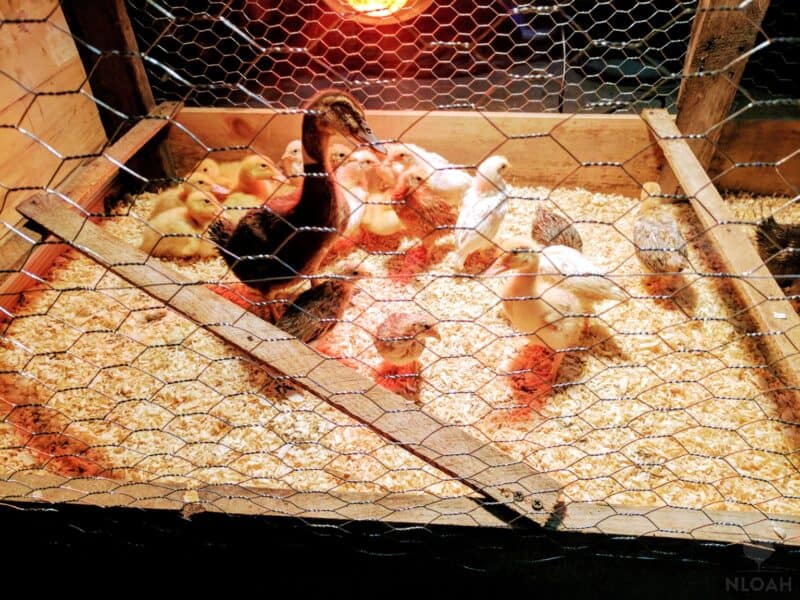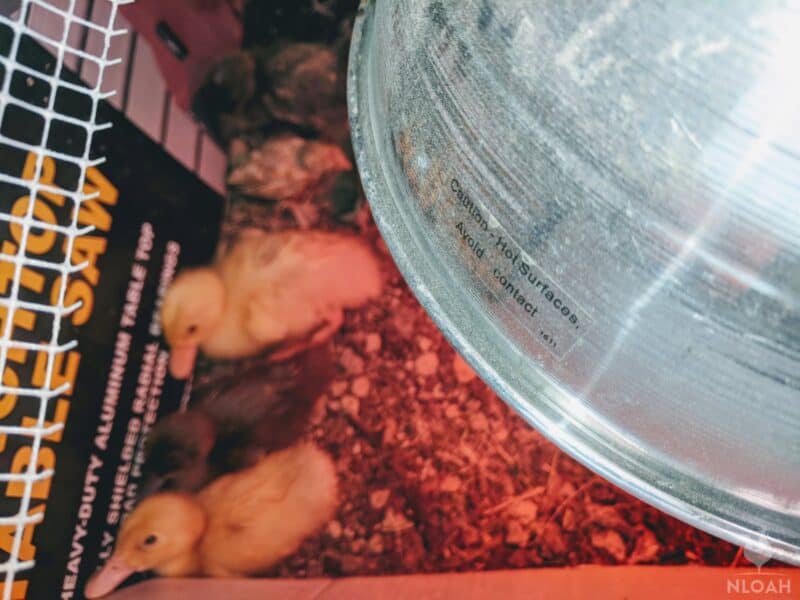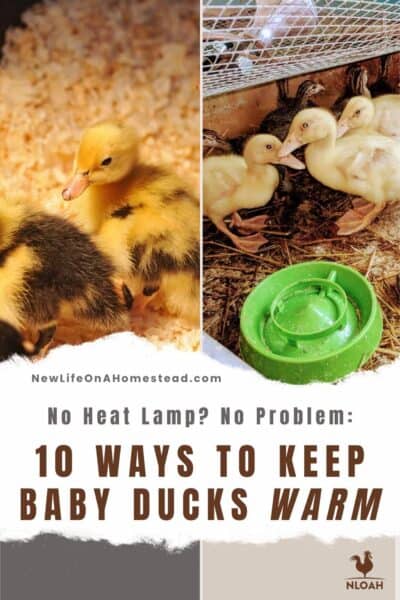Do you want know what the very best part of raising ducks is? Getting baby ducks! Ducklings are incredibly cute and precious and I always love watching them grow and getting them to bond with me, but they’re also delicate and fragile.

But as you might expect, baby ducks are particularly prone to chilling and getting sick, which can often spell death for the poor things.
Ducklings that are raised by their mom won’t have to worry since she’ll keep them warm. But if your precious babies have hatched in an incubator or you bought newborns it will be up to you: Until they grow enough to regulate their body temperature on their own and get their adult feathers, they will be vulnerable.
Heat lamps are an old standby for the job, but these things are so prone to causing fires that concerned duck owners are moving away from them in droves.
That’s okay, because there are plenty of alternatives. Keep reading, and I’ll tell you about some good ones to use so you won’t have to rely on a heat lamp to keep your sweet babies warm.
Remember: Make Sure Ducklings Can Always Move Away from a Heat Source!
One really quick thing before we get to the list. No matter what sort of heat source you use, it is absolutely crucial that your ducklings always have enough room to move away from it. It’s bad for your ducklings to get too cold, but just as bad, or worse, for them to get too hot.
Especially if your brooder is crowded or your ducklings are starting to get bigger, there might not be enough room for all of them to move away from that heat source to cool down when feeling a bit too warm.
See to it that they can by adjusting the heat source, getting a bigger brooder or even getting multiple brooders if you have a big ol’ batch of baby ducks. In any case, ensure no heat source blankets the entirety of the brooder!
Self-Warming Electric Brooder
If you’ve got the money and don’t want to mess around with any add-on or improvised solutions, absolutely nothing beats an electric brooder.
It’s exactly what it sounds like: a brooder that heats itself, and most models can monitor humidity and temperature to let you see if your ducklings are comfortable at a glance.
They are the ultimate in convenience and excellent for changing temperature as your ducklings grow, but they’re quite expensive and, being just another electrical tool, are a risk of fire themselves even though this risk is greatly reduced compared to the old-fashioned heat lamps. Also, if you lose power for any reason, your brooder will stop working!
Infrared Heater
An infrared heater is one that directly converts electricity into heat.
Properly designed for caring for poultry or reptiles, they’re typically safer than heat lamps, have more precise temperature control, and can be placed in such a way as to provide a pool of heat much like a heat lamp while leaving a cool zone for ducklings to retreat into.
They may be a bit pricey, however, and like heat lamps and other direct heat sources, it is very easy for the little things to get overheated if they can’t move away from it for whatever reason.
And as always, if the power goes out, the heat stops and, though they’re much safer than heat lamps, there’s still a risk of fire.
Hot Water Bottles
Absolutely simple, cost-effective, and adaptable, hot water bottles are a wonderful way to supplement the heat available to your baby ducks with absolutely zero risk of a fire at all. But, as good as they are, they have just as many drawbacks…
Obviously, you can’t really control the temperature in a hot water bottle, and they’ll continuously get cooler over time.
If you put very hot water in them, they must still be wrapped in a towel or other covering to prevent direct contact with the birds and, obviously, they require constant management to refresh.
These work best as a temporary or interim solution if you have your ducklings out of the primary brooder for cleaning or some other purpose.
Warmed Towels
Nothing beats a warm towel when you’re going to the barbershop or hair salon, and your ducklings will enjoy it just as much.
Warming up a towel using a specialized heater for the job or even a common hair dryer and then placing it in the brooder for your ducks to snuggle into is an easy and gentle way to warm them quickly with basically no risk of other danger.
But, just like those soothing towels at the barber, warm towels only stay warm for a very short time. Consider this a supplemental method for keeping babies warm when they are out of the brooder or if, for whatever reason, you’ll have some cool drafts coming in that you can’t stop.
Natural Sunlight
Don’t underestimate what the sun can do for you when you need to keep your baby ducks warm. It is all-natural, safe, and helps ducks get ready for a normal waking and sleeping cycle.
But obviously, sunlight has some serious shortcomings, mainly the fact that it is only out in the daytime and only likely to be shining into a window or door at certain times.
Nonetheless, you should definitely make use of natural sunlight to help keep your young flock warm when you can.

Heat Pad
One of the best-kept secrets that isn’t really a secret for keeping ducklings warm. Heat pads are adjustable, affordable, adaptable, and safe, but you have to cover them with a towel or pad to prevent direct contact and know what you are doing to use them properly.
For starters, they tend to be way too hot on anything but the lowest setting, and pretty much every model sold in North America these days has an automatic off function to prevent accidental burns on humans.
That means if you don’t tend to it religiously, it might turn off and let your ducklings get too cold. Still, they are a good choice for supplemental heating or for primary heating of a smaller brood.
Brooder/Terrarium Heating Mat
You can think of heating mats as the proper version of heat pads for raising ducklings. They’re mostly designed for heating brooders or warming up animals of other species, have better temperature control, and are safer all around.
But they tend to be significantly more expensive compared to heat pads, and just like heat pads, they must be covered or placed in such a way that ducklings cannot come directly into contact with them because even on low, they’ll be too hot…
“Heat Cave”
A heat cave is a DIY option for warming your ducklings that is safe, extremely effective, and lets them stay warm at night without a light or anything else disturbing, helping them get more rest.
Basically, you make a heat cave out of an open-front, wire file basket, a heat pad or heat mat, and plenty of duct tape. Sounds strange, but it works really well, and plenty of duck owners report great success with their ducklings.
Baby ducks tend to want to huddle beneath a snug and cozy source of warmth normally because it simulates getting beneath their mother’s feathers. Learn how to make your own right here.
Mother Duck
Sometimes, we humans tend to overthink things. It’s great to raise your own ducklings, but if you’ve got a broody mom that is willing to hatch and raise her babies, consider letting her. That’s the way it has worked in nature for thousands of years, and it still works today.
Most ducks have at least adequate mothering instincts, and ducklings have an instinct to retreat beneath the warm confines of their mother when they start to get too cold.
Assuming you’ve got a good shelter for them that will keep out drafts, they’ll do just fine, and you can spend your time on other things.
Feather Dusters
It might sound funny, but I promise it’s true! Feather dusters are a viable, but contentious, method for helping to keep ducklings warm while also giving them emotional comfort.
A clean, dry feather duster is a surprisingly good insulator and also gives ducklings a sense of safety and security like they are nestling beneath a sort of mother duck stand-in.
But, there are three major caveats: one, feather dusters will catch fire readily, so you can’t use them with anything that has a hot heating element or a surface hot enough to ignite them. The second is that feather dusters only trap heat or provide insulation; they don’t create any heat on their own.
Lastly, there is a small but genuine risk that the strands of a feather duster could get wrapped around the little chicks underneath, strangling them or cutting off circulation with deadly results. If you use a feather duster, hang it upright in the brooder so the tips are slightly off the ground and don’t leave ducklings unattended.

Tom has lived and worked on farms and homesteads from the Carolinas to Kentucky and beyond. He is passionate about helping people prepare for tough times by embracing lifestyles of self-sufficiency.
